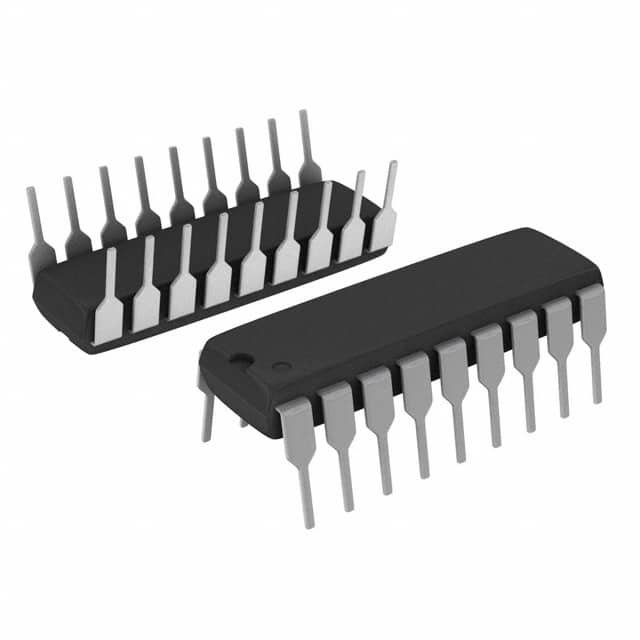Подробную информацию о продукте см. в характеристиках.

PIC16F716-I/P
Product Overview
Category
The PIC16F716-I/P belongs to the category of microcontrollers.
Use
This microcontroller is commonly used in various electronic devices and systems for controlling and processing data.
Characteristics
- Low power consumption
- High-performance RISC CPU
- Wide operating voltage range
- Flash program memory
- EEPROM data memory
- I/O ports with individual direction control
- Timers and counters
- Analog-to-digital converter (ADC)
- Serial communication interfaces
Package
The PIC16F716-I/P is available in a 14-pin plastic dual inline package (PDIP).
Essence
The essence of the PIC16F716-I/P lies in its ability to provide a compact and versatile solution for embedded control applications.
Packaging/Quantity
This microcontroller is typically packaged in tubes or trays, with quantities varying depending on the supplier and customer requirements.
Specifications
- CPU: 8-bit RISC
- Program Memory: 3.5 KB Flash
- Data Memory: 128 bytes EEPROM
- I/O Pins: 12
- ADC Channels: 5
- Timers: 2
- Communication Interfaces: USART, SPI, I2C
- Operating Voltage Range: 2.0V to 5.5V
- Operating Temperature Range: -40°C to +85°C
Detailed Pin Configuration
The PIC16F716-I/P has a total of 14 pins, each serving a specific purpose. The pin configuration is as follows:
- VDD - Power supply voltage
- RA0/AN0 - Analog input channel 0 / Digital I/O pin
- RA1/AN1 - Analog input channel 1 / Digital I/O pin
- RA2/AN2 - Analog input channel 2 / Digital I/O pin
- RA3/AN3 - Analog input channel 3 / Digital I/O pin
- RA4/T0CKI/C1OUT - Timer0 clock input / Digital I/O pin / Comparator output
- MCLR/VPP - Master Clear input / Programming voltage supply
- VSS - Ground
- RB0/INT - External interrupt input / Digital I/O pin
- RB1/SDI/SDA - Serial data input (SPI) / I2C data line
- RB2/SDO/SCL - Serial data output (SPI) / I2C clock line
- RB3/PGM - Programming mode control
- RB4/PGC - Programming clock input
- RB5/PGD - Programming data I/O
Functional Features
The PIC16F716-I/P offers several functional features that enhance its usability and performance:
- High-speed processing capabilities
- Flexible I/O ports for interfacing with external devices
- On-chip timers and counters for precise timing operations
- Analog-to-digital converter for capturing analog signals
- Serial communication interfaces for data exchange with other devices
- Flash program memory for storing user code
- EEPROM data memory for non-volatile storage
Advantages and Disadvantages
Advantages
- Low power consumption extends battery life in portable applications.
- Wide operating voltage range allows compatibility with various power sources.
- Compact package size enables integration into space-constrained designs.
- Versatile I/O capabilities facilitate connectivity with external components.
- On-chip peripherals reduce the need for additional external components.
Disadvantages
- Limited program memory may restrict the complexity of applications.
- The number of I/O pins may be insufficient for certain projects.
- Lack of advanced features compared to more powerful microcontrollers.
Working Principles
The PIC16F716-I/P operates based on the principles of a reduced instruction set computer (RISC) architecture. It executes instructions stored in its program memory, manipulating data and controlling external devices through its I/O ports. The microcontroller's central processing unit (CPU) performs arithmetic, logical, and control operations to carry out the desired tasks.
Detailed Application Field Plans
The PIC16F716-I/P finds applications in various fields, including but not limited to:
- Home automation systems
- Industrial control systems
- Automotive electronics
- Medical devices
- Consumer electronics
- Internet of Things (IoT) devices
- Robotics
- Sensor networks
Detailed and Complete Alternative Models
For those seeking alternative microcontrollers with similar capabilities, the following models can be considered:
- PIC16F716-I/SP - Same features as PIC16F716-I/P but in a 14-pin plastic small outline package (SOIC).
- PIC16F716-E/ML - Extended temperature range version (-40°C to +125°C) in a 20-pin QFN package.
- PIC16F716
Перечислите 10 распространенных вопросов и ответов, связанных с применением PIC16F716-I/P в технических решениях.
What is the maximum operating frequency of PIC16F716-I/P?
- The maximum operating frequency of PIC16F716-I/P is 20 MHz.Can PIC16F716-I/P be used for battery-powered applications?
- Yes, PIC16F716-I/P is suitable for battery-powered applications due to its low power consumption.What are the communication interfaces supported by PIC16F716-I/P?
- PIC16F716-I/P supports SPI and I2C communication interfaces.Is PIC16F716-I/P suitable for motor control applications?
- Yes, PIC16F716-I/P can be used for simple motor control applications.What are the available memory options in PIC16F716-I/P?
- PIC16F716-I/P has 3.5 KB of flash memory and 128 bytes of RAM.Can PIC16F716-I/P be programmed using C language?
- Yes, PIC16F716-I/P can be programmed using C language with appropriate compilers.Does PIC16F716-I/P have built-in analog-to-digital converters (ADC)?
- Yes, PIC16F716-I/P has a 10-bit ADC with multiple channels.What are the recommended operating conditions for PIC16F716-I/P?
- The recommended operating voltage range for PIC16F716-I/P is 2.0V to 5.5V.Can PIC16F716-I/P be used in automotive applications?
- Yes, PIC16F716-I/P is suitable for certain automotive applications within specified temperature ranges.Are there any development boards available for PIC16F716-I/P?
- Yes, there are development boards specifically designed for PIC16F716-I/P to aid in prototyping and testing.

